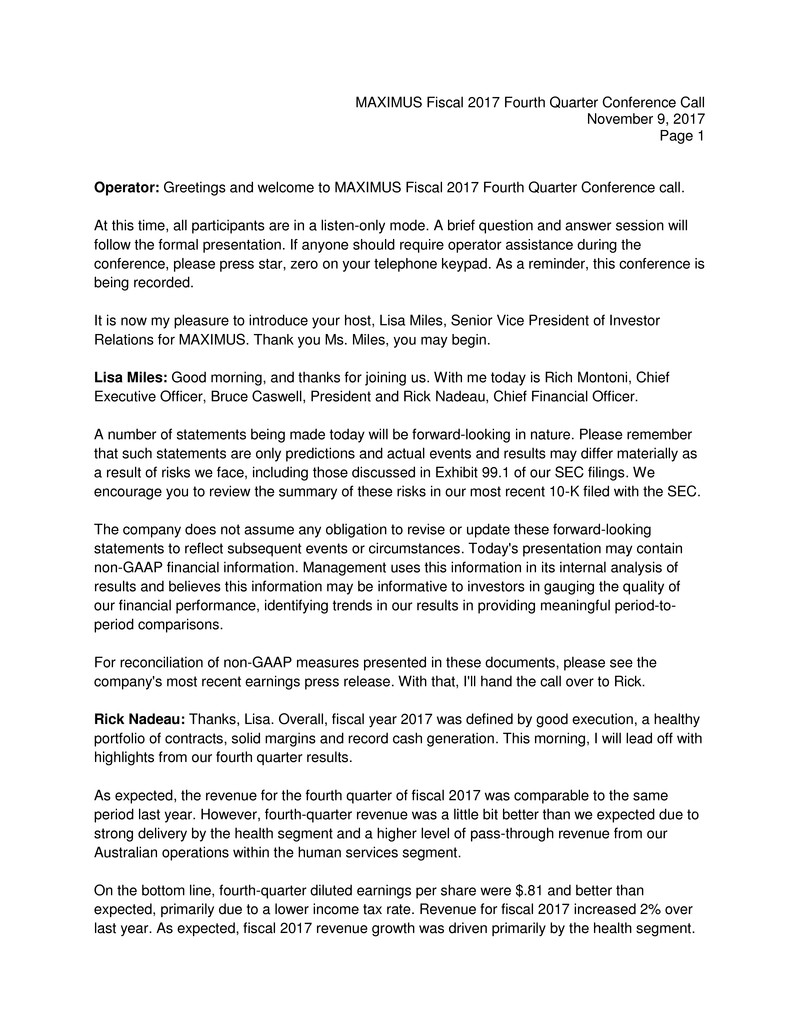
MAXIMUS Fiscal 2017 Fourth Quarter Conference Call
November 9, 2017
Page 1
Operator: Greetings and welcome to MAXIMUS Fiscal 2017 Fourth Quarter Conference call.
At this time, all participants are in a listen-only mode. A brief question and answer session will
follow the formal presentation. If anyone should require operator assistance during the
conference, please press star, zero on your telephone keypad. As a reminder, this conference is
being recorded.
It is now my pleasure to introduce your host, Lisa Miles, Senior Vice President of Investor
Relations for MAXIMUS. Thank you Ms. Miles, you may begin.
Lisa Miles: Good morning, and thanks for joining us. With me today is Rich Montoni, Chief
Executive Officer, Bruce Caswell, President and Rick Nadeau, Chief Financial Officer.
A number of statements being made today will be forward-looking in nature. Please remember
that such statements are only predictions and actual events and results may differ materially as
a result of risks we face, including those discussed in Exhibit 99.1 of our SEC filings. We
encourage you to review the summary of these risks in our most recent 10-K filed with the SEC.
The company does not assume any obligation to revise or update these forward-looking
statements to reflect subsequent events or circumstances. Today's presentation may contain
non-GAAP financial information. Management uses this information in its internal analysis of
results and believes this information may be informative to investors in gauging the quality of
our financial performance, identifying trends in our results in providing meaningful period-to-
period comparisons.
For reconciliation of non-GAAP measures presented in these documents, please see the
company's most recent earnings press release. With that, I'll hand the call over to Rick.
Rick Nadeau: Thanks, Lisa. Overall, fiscal year 2017 was defined by good execution, a healthy
portfolio of contracts, solid margins and record cash generation. This morning, I will lead off with
highlights from our fourth quarter results.
As expected, the revenue for the fourth quarter of fiscal 2017 was comparable to the same
period last year. However, fourth-quarter revenue was a little bit better than we expected due to
strong delivery by the health segment and a higher level of pass-through revenue from our
Australian operations within the human services segment.
On the bottom line, fourth-quarter diluted earnings per share were $.81 and better than
expected, primarily due to a lower income tax rate. Revenue for fiscal 2017 increased 2% over
last year. As expected, fiscal 2017 revenue growth was driven primarily by the health segment.
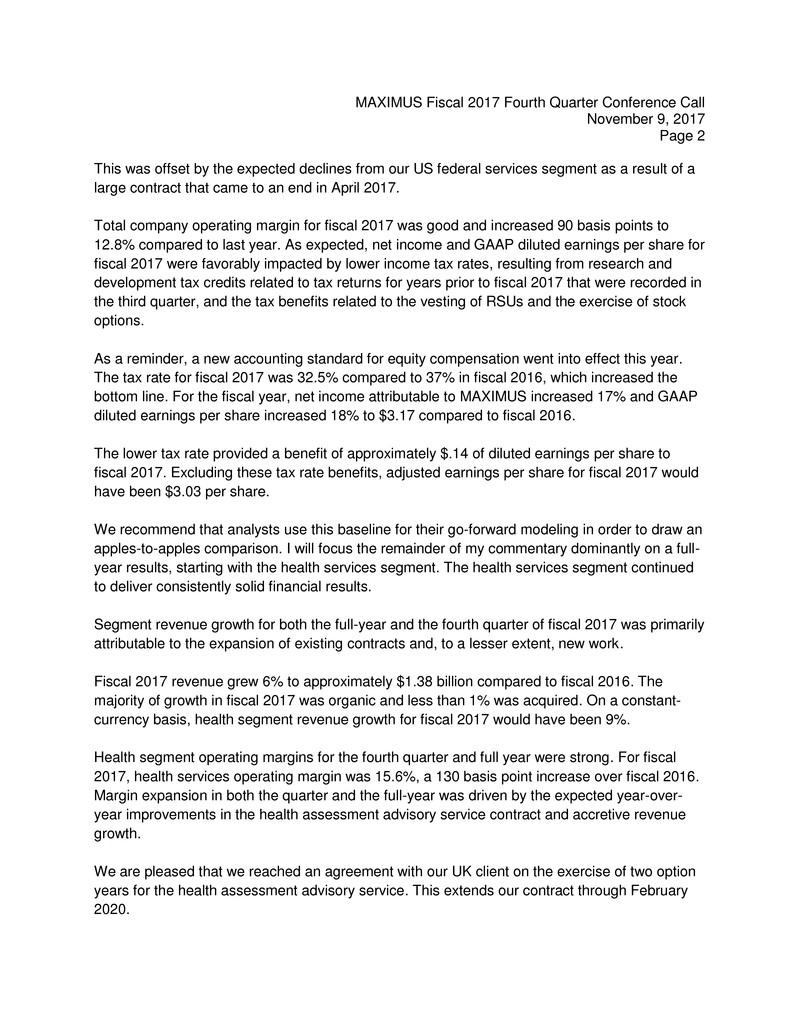
MAXIMUS Fiscal 2017 Fourth Quarter Conference Call
November 9, 2017
Page 2
This was offset by the expected declines from our US federal services segment as a result of a
large contract that came to an end in April 2017.
Total company operating margin for fiscal 2017 was good and increased 90 basis points to
12.8% compared to last year. As expected, net income and GAAP diluted earnings per share for
fiscal 2017 were favorably impacted by lower income tax rates, resulting from research and
development tax credits related to tax returns for years prior to fiscal 2017 that were recorded in
the third quarter, and the tax benefits related to the vesting of RSUs and the exercise of stock
options.
As a reminder, a new accounting standard for equity compensation went into effect this year.
The tax rate for fiscal 2017 was 32.5% compared to 37% in fiscal 2016, which increased the
bottom line. For the fiscal year, net income attributable to MAXIMUS increased 17% and GAAP
diluted earnings per share increased 18% to $3.17 compared to fiscal 2016.
The lower tax rate provided a benefit of approximately $.14 of diluted earnings per share to
fiscal 2017. Excluding these tax rate benefits, adjusted earnings per share for fiscal 2017 would
have been $3.03 per share.
We recommend that analysts use this baseline for their go-forward modeling in order to draw an
apples-to-apples comparison. I will focus the remainder of my commentary dominantly on a full-
year results, starting with the health services segment. The health services segment continued
to deliver consistently solid financial results.
Segment revenue growth for both the full-year and the fourth quarter of fiscal 2017 was primarily
attributable to the expansion of existing contracts and, to a lesser extent, new work.
Fiscal 2017 revenue grew 6% to approximately $1.38 billion compared to fiscal 2016. The
majority of growth in fiscal 2017 was organic and less than 1% was acquired. On a constant-
currency basis, health segment revenue growth for fiscal 2017 would have been 9%.
Health segment operating margins for the fourth quarter and full year were strong. For fiscal
2017, health services operating margin was 15.6%, a 130 basis point increase over fiscal 2016.
Margin expansion in both the quarter and the full-year was driven by the expected year-over-
year improvements in the health assessment advisory service contract and accretive revenue
growth.
We are pleased that we reached an agreement with our UK client on the exercise of two option
years for the health assessment advisory service. This extends our contract through February
2020.
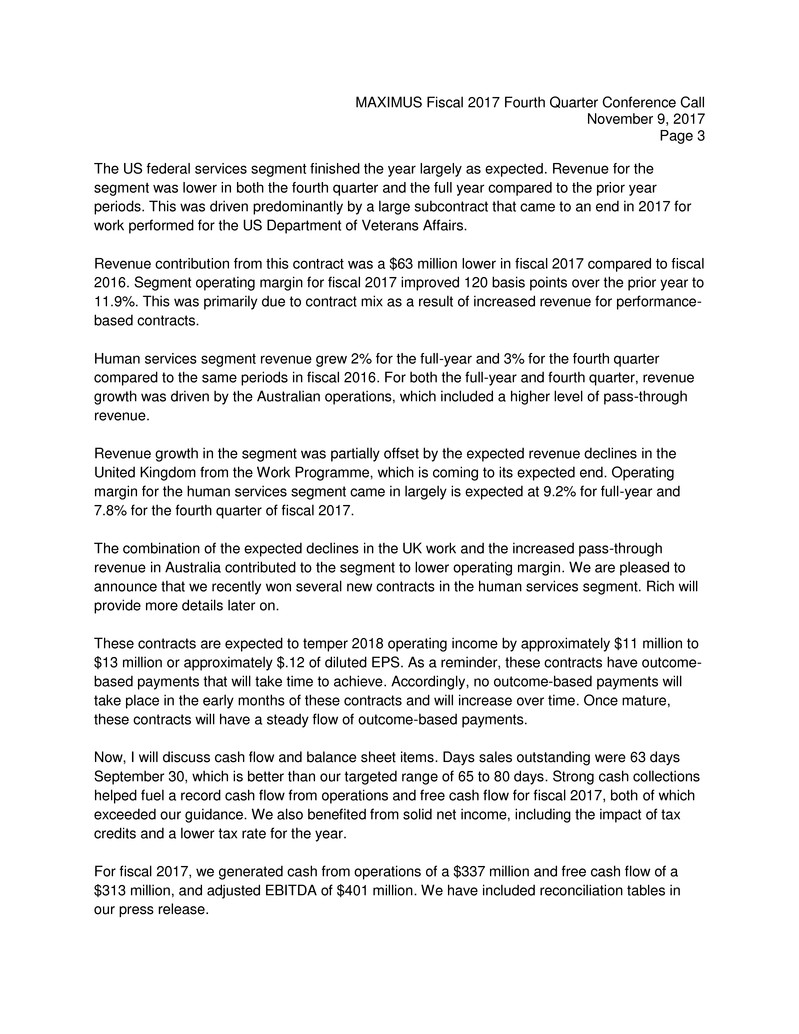
MAXIMUS Fiscal 2017 Fourth Quarter Conference Call
November 9, 2017
Page 3
The US federal services segment finished the year largely as expected. Revenue for the
segment was lower in both the fourth quarter and the full year compared to the prior year
periods. This was driven predominantly by a large subcontract that came to an end in 2017 for
work performed for the US Department of Veterans Affairs.
Revenue contribution from this contract was a $63 million lower in fiscal 2017 compared to fiscal
2016. Segment operating margin for fiscal 2017 improved 120 basis points over the prior year to
11.9%. This was primarily due to contract mix as a result of increased revenue for performance-
based contracts.
Human services segment revenue grew 2% for the full-year and 3% for the fourth quarter
compared to the same periods in fiscal 2016. For both the full-year and fourth quarter, revenue
growth was driven by the Australian operations, which included a higher level of pass-through
revenue.
Revenue growth in the segment was partially offset by the expected revenue declines in the
United Kingdom from the Work Programme, which is coming to its expected end. Operating
margin for the human services segment came in largely is expected at 9.2% for full-year and
7.8% for the fourth quarter of fiscal 2017.
The combination of the expected declines in the UK work and the increased pass-through
revenue in Australia contributed to the segment to lower operating margin. We are pleased to
announce that we recently won several new contracts in the human services segment. Rich will
provide more details later on.
These contracts are expected to temper 2018 operating income by approximately $11 million to
$13 million or approximately $.12 of diluted EPS. As a reminder, these contracts have outcome-
based payments that will take time to achieve. Accordingly, no outcome-based payments will
take place in the early months of these contracts and will increase over time. Once mature,
these contracts will have a steady flow of outcome-based payments.
Now, I will discuss cash flow and balance sheet items. Days sales outstanding were 63 days
September 30, which is better than our targeted range of 65 to 80 days. Strong cash collections
helped fuel a record cash flow from operations and free cash flow for fiscal 2017, both of which
exceeded our guidance. We also benefited from solid net income, including the impact of tax
credits and a lower tax rate for the year.
For fiscal 2017, we generated cash from operations of a $337 million and free cash flow of a
$313 million, and adjusted EBITDA of $401 million. We have included reconciliation tables in
our press release.
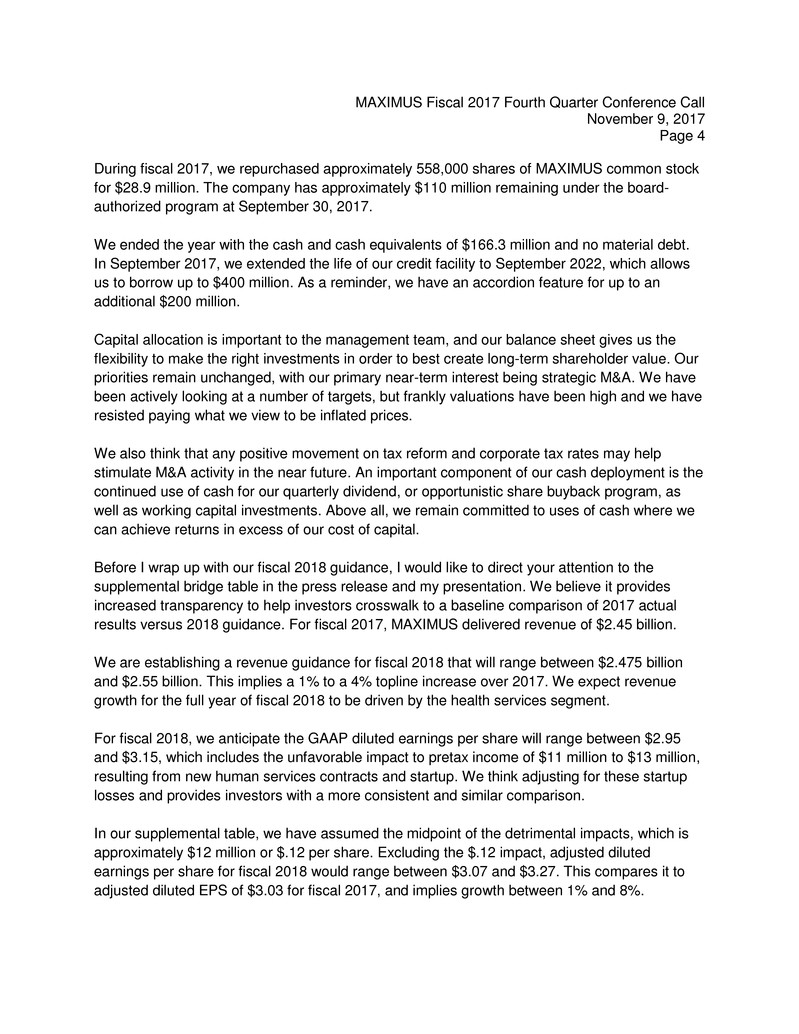
MAXIMUS Fiscal 2017 Fourth Quarter Conference Call
November 9, 2017
Page 4
During fiscal 2017, we repurchased approximately 558,000 shares of MAXIMUS common stock
for $28.9 million. The company has approximately $110 million remaining under the board-
authorized program at September 30, 2017.
We ended the year with the cash and cash equivalents of $166.3 million and no material debt.
In September 2017, we extended the life of our credit facility to September 2022, which allows
us to borrow up to $400 million. As a reminder, we have an accordion feature for up to an
additional $200 million.
Capital allocation is important to the management team, and our balance sheet gives us the
flexibility to make the right investments in order to best create long-term shareholder value. Our
priorities remain unchanged, with our primary near-term interest being strategic M&A. We have
been actively looking at a number of targets, but frankly valuations have been high and we have
resisted paying what we view to be inflated prices.
We also think that any positive movement on tax reform and corporate tax rates may help
stimulate M&A activity in the near future. An important component of our cash deployment is the
continued use of cash for our quarterly dividend, or opportunistic share buyback program, as
well as working capital investments. Above all, we remain committed to uses of cash where we
can achieve returns in excess of our cost of capital.
Before I wrap up with our fiscal 2018 guidance, I would like to direct your attention to the
supplemental bridge table in the press release and my presentation. We believe it provides
increased transparency to help investors crosswalk to a baseline comparison of 2017 actual
results versus 2018 guidance. For fiscal 2017, MAXIMUS delivered revenue of $2.45 billion.
We are establishing a revenue guidance for fiscal 2018 that will range between $2.475 billion
and $2.55 billion. This implies a 1% to a 4% topline increase over 2017. We expect revenue
growth for the full year of fiscal 2018 to be driven by the health services segment.
For fiscal 2018, we anticipate the GAAP diluted earnings per share will range between $2.95
and $3.15, which includes the unfavorable impact to pretax income of $11 million to $13 million,
resulting from new human services contracts and startup. We think adjusting for these startup
losses and provides investors with a more consistent and similar comparison.
In our supplemental table, we have assumed the midpoint of the detrimental impacts, which is
approximately $12 million or $.12 per share. Excluding the $.12 impact, adjusted diluted
earnings per share for fiscal 2018 would range between $3.07 and $3.27. This compares it to
adjusted diluted EPS of $3.03 for fiscal 2017, and implies growth between 1% and 8%.
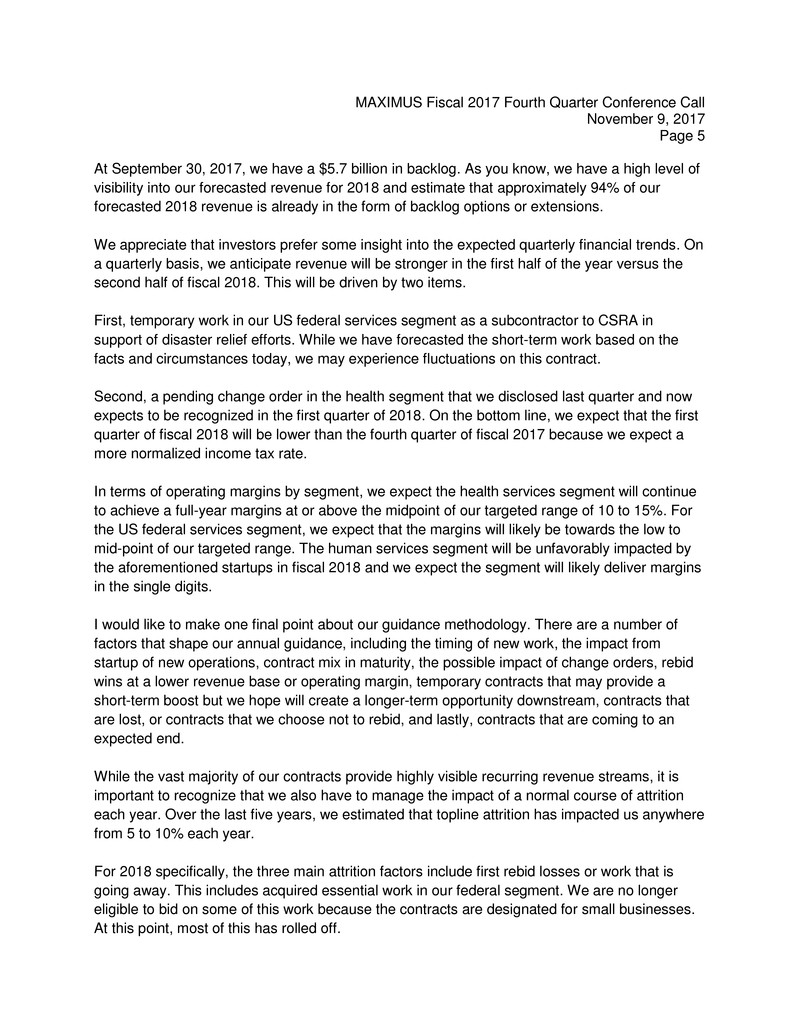
MAXIMUS Fiscal 2017 Fourth Quarter Conference Call
November 9, 2017
Page 5
At September 30, 2017, we have a $5.7 billion in backlog. As you know, we have a high level of
visibility into our forecasted revenue for 2018 and estimate that approximately 94% of our
forecasted 2018 revenue is already in the form of backlog options or extensions.
We appreciate that investors prefer some insight into the expected quarterly financial trends. On
a quarterly basis, we anticipate revenue will be stronger in the first half of the year versus the
second half of fiscal 2018. This will be driven by two items.
First, temporary work in our US federal services segment as a subcontractor to CSRA in
support of disaster relief efforts. While we have forecasted the short-term work based on the
facts and circumstances today, we may experience fluctuations on this contract.
Second, a pending change order in the health segment that we disclosed last quarter and now
expects to be recognized in the first quarter of 2018. On the bottom line, we expect that the first
quarter of fiscal 2018 will be lower than the fourth quarter of fiscal 2017 because we expect a
more normalized income tax rate.
In terms of operating margins by segment, we expect the health services segment will continue
to achieve a full-year margins at or above the midpoint of our targeted range of 10 to 15%. For
the US federal services segment, we expect that the margins will likely be towards the low to
mid-point of our targeted range. The human services segment will be unfavorably impacted by
the aforementioned startups in fiscal 2018 and we expect the segment will likely deliver margins
in the single digits.
I would like to make one final point about our guidance methodology. There are a number of
factors that shape our annual guidance, including the timing of new work, the impact from
startup of new operations, contract mix in maturity, the possible impact of change orders, rebid
wins at a lower revenue base or operating margin, temporary contracts that may provide a
short-term boost but we hope will create a longer-term opportunity downstream, contracts that
are lost, or contracts that we choose not to rebid, and lastly, contracts that are coming to an
expected end.
While the vast majority of our contracts provide highly visible recurring revenue streams, it is
important to recognize that we also have to manage the impact of a normal course of attrition
each year. Over the last five years, we estimated that topline attrition has impacted us anywhere
from 5 to 10% each year.
For 2018 specifically, the three main attrition factors include first rebid losses or work that is
going away. This includes acquired essential work in our federal segment. We are no longer
eligible to bid on some of this work because the contracts are designated for small businesses.
At this point, most of this has rolled off.

MAXIMUS Fiscal 2017 Fourth Quarter Conference Call
November 9, 2017
Page 6
Second, work that has been rebid or extended, but at a lower rate and, third, forecasted
changes in volumes. We believe that this is an important element to consider when investors
are modeling our results. For the full year of 2018, we estimate the income tax rate will range
between 35 and 36%. As you know, the final income tax rate will ultimately depend on the mix
of operating income contribution from our various tax jurisdictions as well as the closing price of
MAXIMUS common stock on September 30, 2018.
For fiscal 2018, we have also assumed weighted average shares outstanding of 66.5 million.
And finally, cash flow guidance; we expected cash provided by operations to be in the range of
$200 million to $250 million for 2018. And we expect free cash flow to range between $170
million and $220 million. With that, I will hand the call over to Rich.
Rich Nadeau: Thank you, Rick, and good morning everyone. We finished fiscal 2017 on firm
footing, with healthy operating margin and record cash flow. In today's prepared remarks, I will
give a brief update on the open enrollment period for the Affordable Care Act. I will then
highlight several recent new work awards that provide paths to long-term growth, as well as
some successful rebids that help protect the base.
Let's start with an update on the Affordable Care Act. The Affordable Care Act open enrollment
period began on November 1, and based on press coverage this week, initial reports from the
federal marketplace in several state-based exchanges show that Americans appear to be
signing up for coverage at a higher rate than last year.
We're seeing similar early trends during the first few days of open enrollment at our state-based
exchange contact centers, with slightly higher call volumes compared to last year. It's hard to
speculate exactly why the volumes are a bit higher, but anecdotally we've received a number of
calls from consumers who think they might be losing coverage as a result of the legislative
efforts to repeal and replace ACA.
On last quarter's call, we talked about actively planting the seeds for long-term growth. For
example, applying our core competencies into new programs and for new clients. During fiscal
2017, we converted several of these opportunities into new contracts in the US and abroad. In
the US, we further expanded our long-term services and supports assessment business, often
referred to as LTSS.
We recently were notified of an award on three new contracts for pre-admission screening and
resident review services known as PASRR. These assessments help ensure appropriate
placements in a nursing facility or community-based setting for certain individuals, and also help
ensure they receive the required services regardless of placement. We are awaiting the final
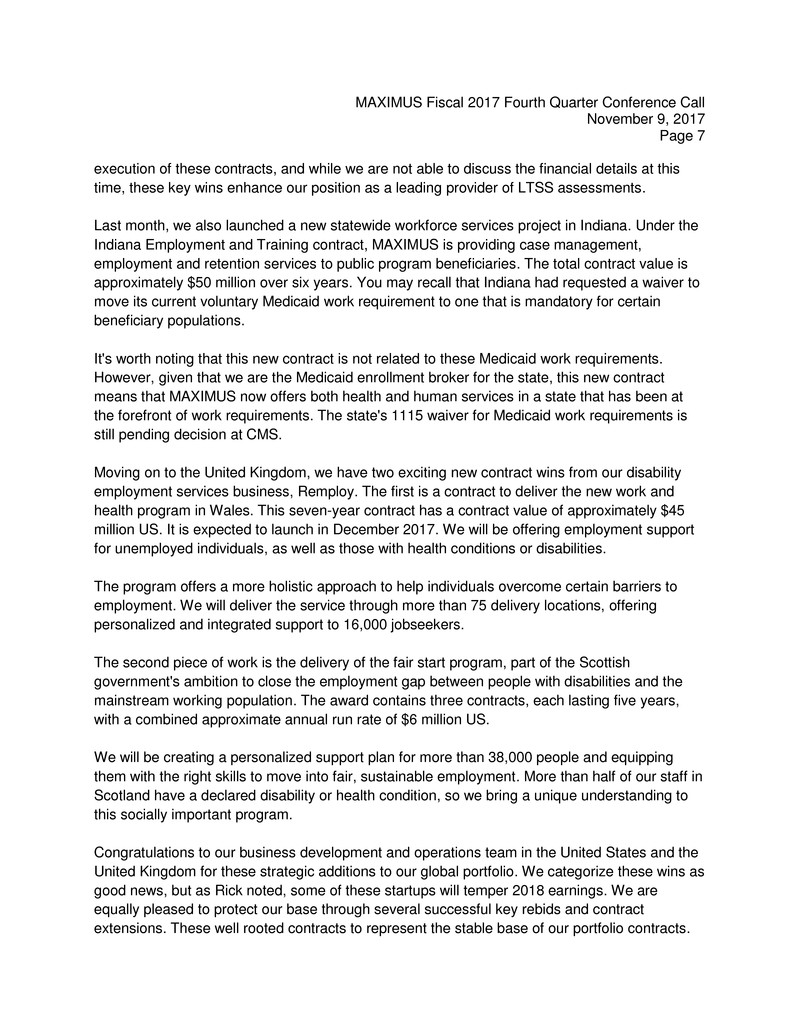
MAXIMUS Fiscal 2017 Fourth Quarter Conference Call
November 9, 2017
Page 7
execution of these contracts, and while we are not able to discuss the financial details at this
time, these key wins enhance our position as a leading provider of LTSS assessments.
Last month, we also launched a new statewide workforce services project in Indiana. Under the
Indiana Employment and Training contract, MAXIMUS is providing case management,
employment and retention services to public program beneficiaries. The total contract value is
approximately $50 million over six years. You may recall that Indiana had requested a waiver to
move its current voluntary Medicaid work requirement to one that is mandatory for certain
beneficiary populations.
It's worth noting that this new contract is not related to these Medicaid work requirements.
However, given that we are the Medicaid enrollment broker for the state, this new contract
means that MAXIMUS now offers both health and human services in a state that has been at
the forefront of work requirements. The state's 1115 waiver for Medicaid work requirements is
still pending decision at CMS.
Moving on to the United Kingdom, we have two exciting new contract wins from our disability
employment services business, Remploy. The first is a contract to deliver the new work and
health program in Wales. This seven-year contract has a contract value of approximately $45
million US. It is expected to launch in December 2017. We will be offering employment support
for unemployed individuals, as well as those with health conditions or disabilities.
The program offers a more holistic approach to help individuals overcome certain barriers to
employment. We will deliver the service through more than 75 delivery locations, offering
personalized and integrated support to 16,000 jobseekers.
The second piece of work is the delivery of the fair start program, part of the Scottish
government's ambition to close the employment gap between people with disabilities and the
mainstream working population. The award contains three contracts, each lasting five years,
with a combined approximate annual run rate of $6 million US.
We will be creating a personalized support plan for more than 38,000 people and equipping
them with the right skills to move into fair, sustainable employment. More than half of our staff in
Scotland have a declared disability or health condition, so we bring a unique understanding to
this socially important program.
Congratulations to our business development and operations team in the United States and the
United Kingdom for these strategic additions to our global portfolio. We categorize these wins as
good news, but as Rick noted, some of these startups will temper 2018 earnings. We are
equally pleased to protect our base through several successful key rebids and contract
extensions. These well rooted contracts to represent the stable base of our portfolio contracts.
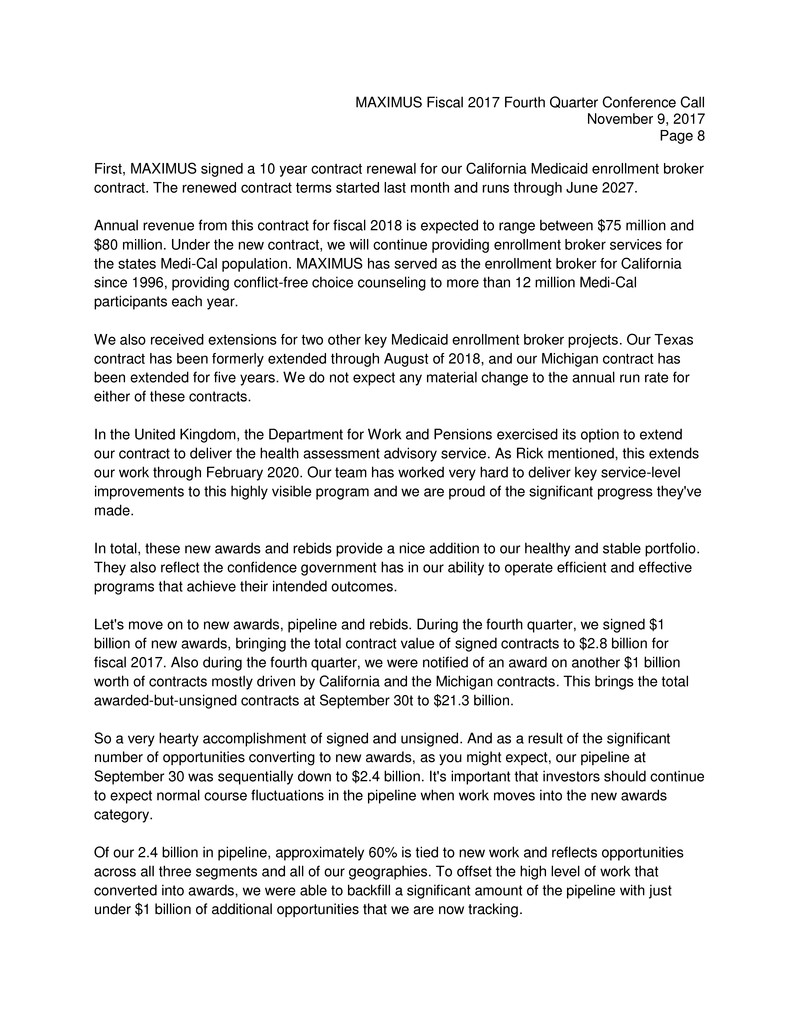
MAXIMUS Fiscal 2017 Fourth Quarter Conference Call
November 9, 2017
Page 8
First, MAXIMUS signed a 10 year contract renewal for our California Medicaid enrollment broker
contract. The renewed contract terms started last month and runs through June 2027.
Annual revenue from this contract for fiscal 2018 is expected to range between $75 million and
$80 million. Under the new contract, we will continue providing enrollment broker services for
the states Medi-Cal population. MAXIMUS has served as the enrollment broker for California
since 1996, providing conflict-free choice counseling to more than 12 million Medi-Cal
participants each year.
We also received extensions for two other key Medicaid enrollment broker projects. Our Texas
contract has been formerly extended through August of 2018, and our Michigan contract has
been extended for five years. We do not expect any material change to the annual run rate for
either of these contracts.
In the United Kingdom, the Department for Work and Pensions exercised its option to extend
our contract to deliver the health assessment advisory service. As Rick mentioned, this extends
our work through February 2020. Our team has worked very hard to deliver key service-level
improvements to this highly visible program and we are proud of the significant progress they've
made.
In total, these new awards and rebids provide a nice addition to our healthy and stable portfolio.
They also reflect the confidence government has in our ability to operate efficient and effective
programs that achieve their intended outcomes.
Let's move on to new awards, pipeline and rebids. During the fourth quarter, we signed $1
billion of new awards, bringing the total contract value of signed contracts to $2.8 billion for
fiscal 2017. Also during the fourth quarter, we were notified of an award on another $1 billion
worth of contracts mostly driven by California and the Michigan contracts. This brings the total
awarded-but-unsigned contracts at September 30t to $21.3 billion.
So a very hearty accomplishment of signed and unsigned. And as a result of the significant
number of opportunities converting to new awards, as you might expect, our pipeline at
September 30 was sequentially down to $2.4 billion. It's important that investors should continue
to expect normal course fluctuations in the pipeline when work moves into the new awards
category.
Of our 2.4 billion in pipeline, approximately 60% is tied to new work and reflects opportunities
across all three segments and all of our geographies. To offset the high level of work that
converted into awards, we were able to backfill a significant amount of the pipeline with just
under $1 billion of additional opportunities that we are now tracking.
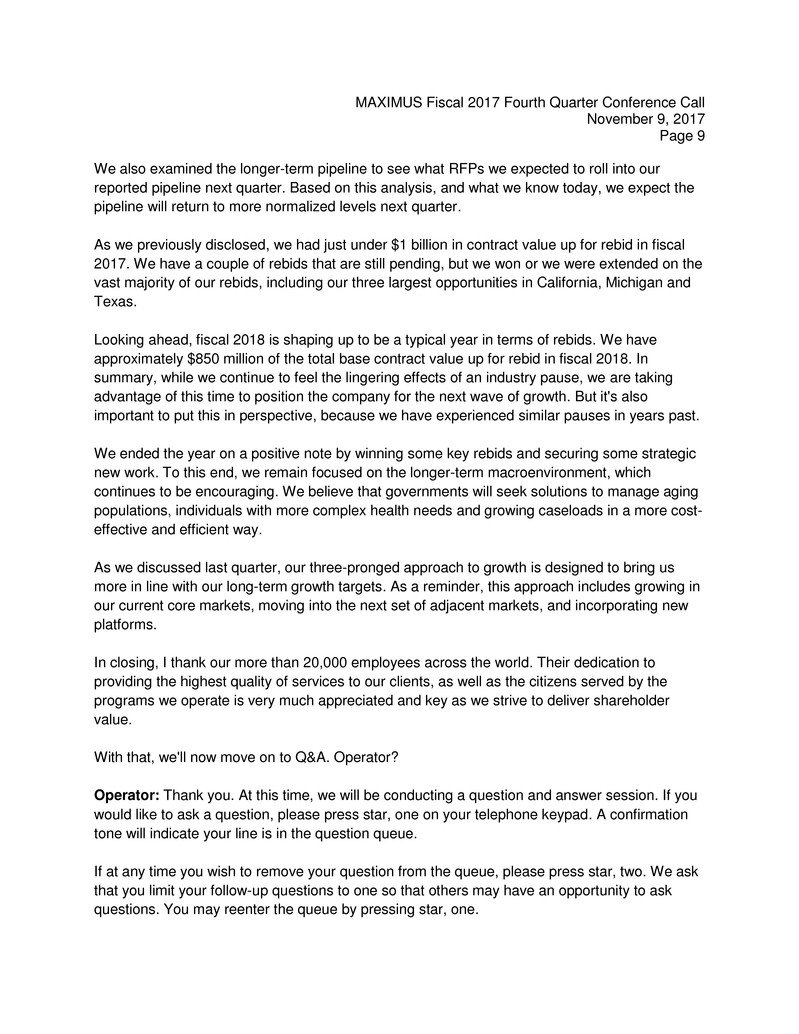
MAXIMUS Fiscal 2017 Fourth Quarter Conference Call
November 9, 2017
Page 9
We also examined the longer-term pipeline to see what RFPs we expected to roll into our
reported pipeline next quarter. Based on this analysis, and what we know today, we expect the
pipeline will return to more normalized levels next quarter.
As we previously disclosed, we had just under $1 billion in contract value up for rebid in fiscal
2017. We have a couple of rebids that are still pending, but we won or we were extended on the
vast majority of our rebids, including our three largest opportunities in California, Michigan and
Texas.
Looking ahead, fiscal 2018 is shaping up to be a typical year in terms of rebids. We have
approximately $850 million of the total base contract value up for rebid in fiscal 2018. In
summary, while we continue to feel the lingering effects of an industry pause, we are taking
advantage of this time to position the company for the next wave of growth. But it's also
important to put this in perspective, because we have experienced similar pauses in years past.
We ended the year on a positive note by winning some key rebids and securing some strategic
new work. To this end, we remain focused on the longer-term macroenvironment, which
continues to be encouraging. We believe that governments will seek solutions to manage aging
populations, individuals with more complex health needs and growing caseloads in a more cost-
effective and efficient way.
As we discussed last quarter, our three-pronged approach to growth is designed to bring us
more in line with our long-term growth targets. As a reminder, this approach includes growing in
our current core markets, moving into the next set of adjacent markets, and incorporating new
platforms.
In closing, I thank our more than 20,000 employees across the world. Their dedication to
providing the highest quality of services to our clients, as well as the citizens served by the
programs we operate is very much appreciated and key as we strive to deliver shareholder
value.
With that, we'll now move on to Q&A. Operator?
Operator: Thank you. At this time, we will be conducting a question and answer session. If you
would like to ask a question, please press star, one on your telephone keypad. A confirmation
tone will indicate your line is in the question queue.
If at any time you wish to remove your question from the queue, please press star, two. We ask
that you limit your follow-up questions to one so that others may have an opportunity to ask
questions. You may reenter the queue by pressing star, one.
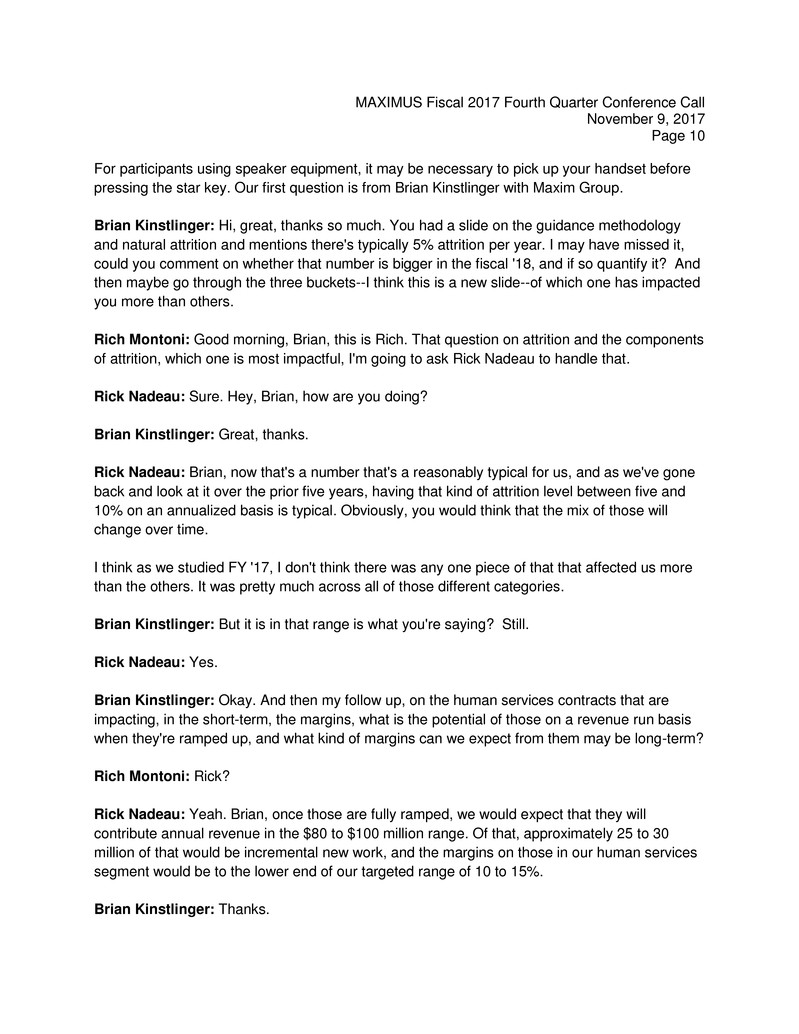
MAXIMUS Fiscal 2017 Fourth Quarter Conference Call
November 9, 2017
Page 10
For participants using speaker equipment, it may be necessary to pick up your handset before
pressing the star key. Our first question is from Brian Kinstlinger with Maxim Group.
Brian Kinstlinger: Hi, great, thanks so much. You had a slide on the guidance methodology
and natural attrition and mentions there's typically 5% attrition per year. I may have missed it,
could you comment on whether that number is bigger in the fiscal '18, and if so quantify it? And
then maybe go through the three buckets--I think this is a new slide--of which one has impacted
you more than others.
Rich Montoni: Good morning, Brian, this is Rich. That question on attrition and the components
of attrition, which one is most impactful, I'm going to ask Rick Nadeau to handle that.
Rick Nadeau: Sure. Hey, Brian, how are you doing?
Brian Kinstlinger: Great, thanks.
Rick Nadeau: Brian, now that's a number that's a reasonably typical for us, and as we've gone
back and look at it over the prior five years, having that kind of attrition level between five and
10% on an annualized basis is typical. Obviously, you would think that the mix of those will
change over time.
I think as we studied FY '17, I don't think there was any one piece of that that affected us more
than the others. It was pretty much across all of those different categories.
Brian Kinstlinger: But it is in that range is what you're saying? Still.
Rick Nadeau: Yes.
Brian Kinstlinger: Okay. And then my follow up, on the human services contracts that are
impacting, in the short-term, the margins, what is the potential of those on a revenue run basis
when they're ramped up, and what kind of margins can we expect from them may be long-term?
Rich Montoni: Rick?
Rick Nadeau: Yeah. Brian, once those are fully ramped, we would expect that they will
contribute annual revenue in the $80 to $100 million range. Of that, approximately 25 to 30
million of that would be incremental new work, and the margins on those in our human services
segment would be to the lower end of our targeted range of 10 to 15%.
Brian Kinstlinger: Thanks.
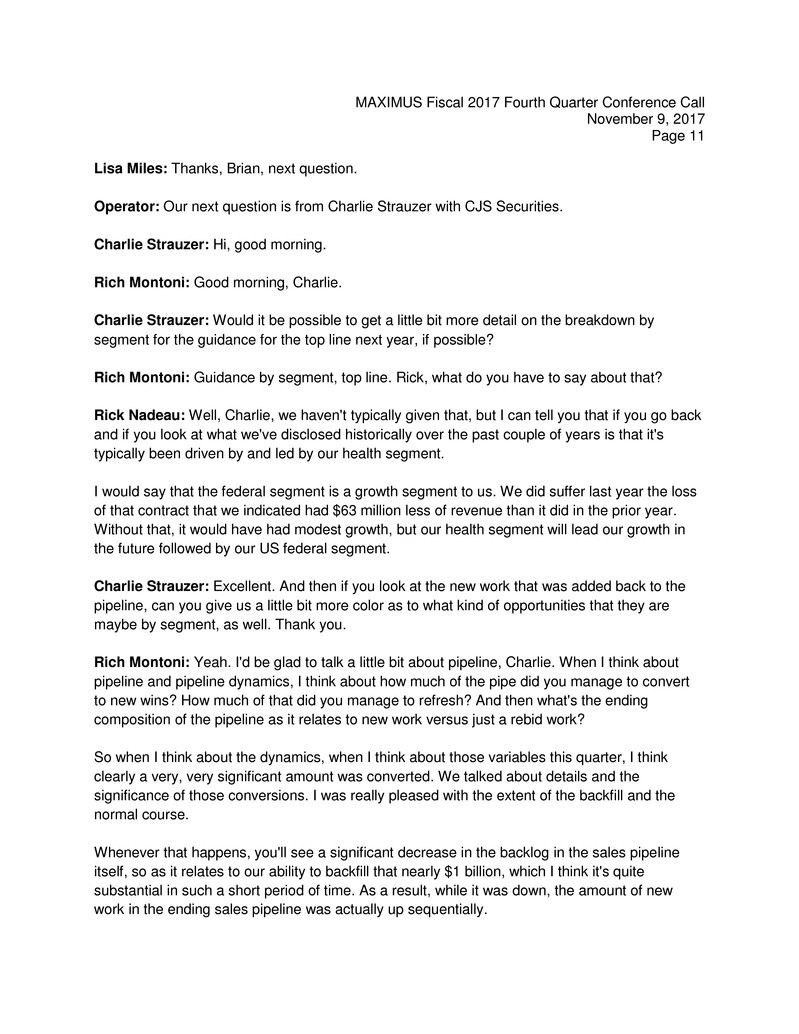
MAXIMUS Fiscal 2017 Fourth Quarter Conference Call
November 9, 2017
Page 11
Lisa Miles: Thanks, Brian, next question.
Operator: Our next question is from Charlie Strauzer with CJS Securities.
Charlie Strauzer: Hi, good morning.
Rich Montoni: Good morning, Charlie.
Charlie Strauzer: Would it be possible to get a little bit more detail on the breakdown by
segment for the guidance for the top line next year, if possible?
Rich Montoni: Guidance by segment, top line. Rick, what do you have to say about that?
Rick Nadeau: Well, Charlie, we haven't typically given that, but I can tell you that if you go back
and if you look at what we've disclosed historically over the past couple of years is that it's
typically been driven by and led by our health segment.
I would say that the federal segment is a growth segment to us. We did suffer last year the loss
of that contract that we indicated had $63 million less of revenue than it did in the prior year.
Without that, it would have had modest growth, but our health segment will lead our growth in
the future followed by our US federal segment.
Charlie Strauzer: Excellent. And then if you look at the new work that was added back to the
pipeline, can you give us a little bit more color as to what kind of opportunities that they are
maybe by segment, as well. Thank you.
Rich Montoni: Yeah. I'd be glad to talk a little bit about pipeline, Charlie. When I think about
pipeline and pipeline dynamics, I think about how much of the pipe did you manage to convert
to new wins? How much of that did you manage to refresh? And then what's the ending
composition of the pipeline as it relates to new work versus just a rebid work?
So when I think about the dynamics, when I think about those variables this quarter, I think
clearly a very, very significant amount was converted. We talked about details and the
significance of those conversions. I was really pleased with the extent of the backfill and the
normal course.
Whenever that happens, you'll see a significant decrease in the backlog in the sales pipeline
itself, so as it relates to our ability to backfill that nearly $1 billion, which I think it's quite
substantial in such a short period of time. As a result, while it was down, the amount of new
work in the ending sales pipeline was actually up sequentially.
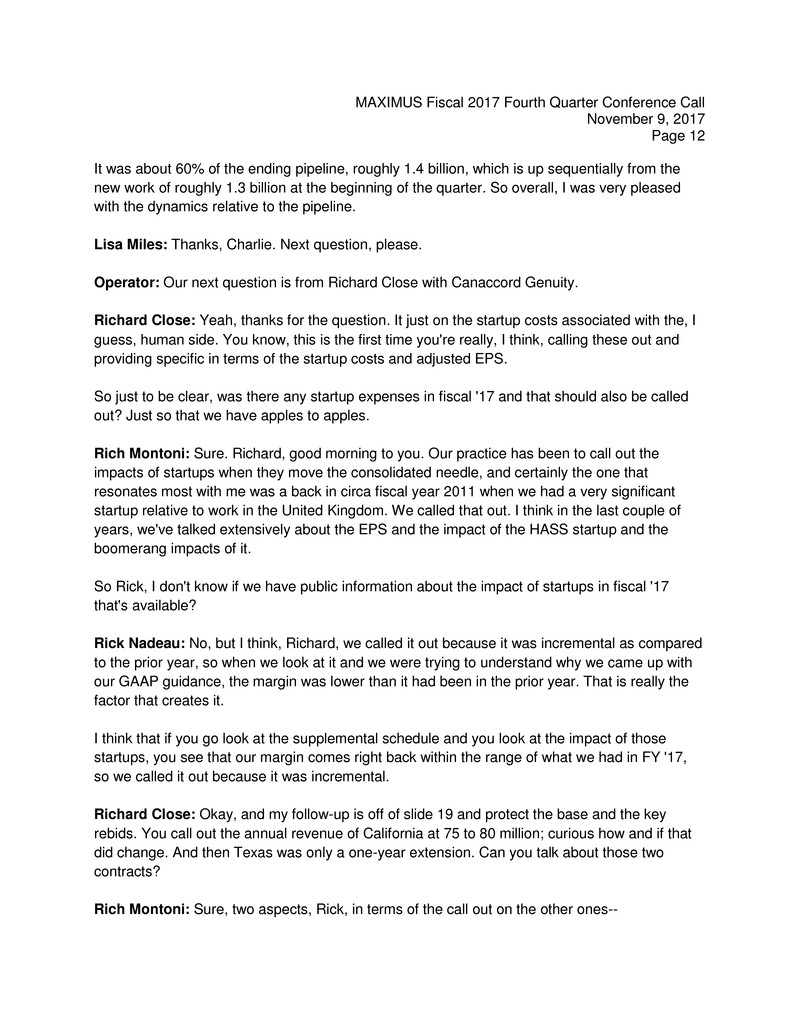
MAXIMUS Fiscal 2017 Fourth Quarter Conference Call
November 9, 2017
Page 12
It was about 60% of the ending pipeline, roughly 1.4 billion, which is up sequentially from the
new work of roughly 1.3 billion at the beginning of the quarter. So overall, I was very pleased
with the dynamics relative to the pipeline.
Lisa Miles: Thanks, Charlie. Next question, please.
Operator: Our next question is from Richard Close with Canaccord Genuity.
Richard Close: Yeah, thanks for the question. It just on the startup costs associated with the, I
guess, human side. You know, this is the first time you're really, I think, calling these out and
providing specific in terms of the startup costs and adjusted EPS.
So just to be clear, was there any startup expenses in fiscal '17 and that should also be called
out? Just so that we have apples to apples.
Rich Montoni: Sure. Richard, good morning to you. Our practice has been to call out the
impacts of startups when they move the consolidated needle, and certainly the one that
resonates most with me was a back in circa fiscal year 2011 when we had a very significant
startup relative to work in the United Kingdom. We called that out. I think in the last couple of
years, we've talked extensively about the EPS and the impact of the HASS startup and the
boomerang impacts of it.
So Rick, I don't know if we have public information about the impact of startups in fiscal '17
that's available?
Rick Nadeau: No, but I think, Richard, we called it out because it was incremental as compared
to the prior year, so when we look at it and we were trying to understand why we came up with
our GAAP guidance, the margin was lower than it had been in the prior year. That is really the
factor that creates it.
I think that if you go look at the supplemental schedule and you look at the impact of those
startups, you see that our margin comes right back within the range of what we had in FY '17,
so we called it out because it was incremental.
Richard Close: Okay, and my follow-up is off of slide 19 and protect the base and the key
rebids. You call out the annual revenue of California at 75 to 80 million; curious how and if that
did change. And then Texas was only a one-year extension. Can you talk about those two
contracts?
Rich Montoni: Sure, two aspects, Rick, in terms of the call out on the other ones--
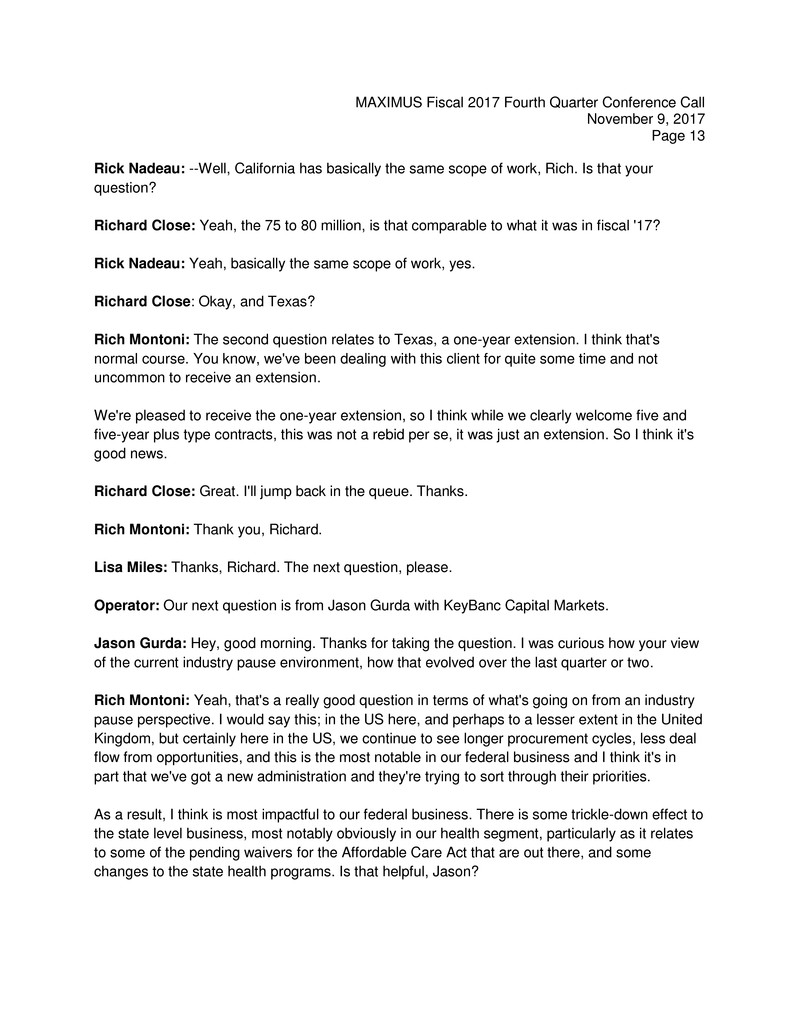
MAXIMUS Fiscal 2017 Fourth Quarter Conference Call
November 9, 2017
Page 13
Rick Nadeau: --Well, California has basically the same scope of work, Rich. Is that your
question?
Richard Close: Yeah, the 75 to 80 million, is that comparable to what it was in fiscal '17?
Rick Nadeau: Yeah, basically the same scope of work, yes.
Richard Close: Okay, and Texas?
Rich Montoni: The second question relates to Texas, a one-year extension. I think that's
normal course. You know, we've been dealing with this client for quite some time and not
uncommon to receive an extension.
We're pleased to receive the one-year extension, so I think while we clearly welcome five and
five-year plus type contracts, this was not a rebid per se, it was just an extension. So I think it's
good news.
Richard Close: Great. I'll jump back in the queue. Thanks.
Rich Montoni: Thank you, Richard.
Lisa Miles: Thanks, Richard. The next question, please.
Operator: Our next question is from Jason Gurda with KeyBanc Capital Markets.
Jason Gurda: Hey, good morning. Thanks for taking the question. I was curious how your view
of the current industry pause environment, how that evolved over the last quarter or two.
Rich Montoni: Yeah, that's a really good question in terms of what's going on from an industry
pause perspective. I would say this; in the US here, and perhaps to a lesser extent in the United
Kingdom, but certainly here in the US, we continue to see longer procurement cycles, less deal
flow from opportunities, and this is the most notable in our federal business and I think it's in
part that we've got a new administration and they're trying to sort through their priorities.
As a result, I think is most impactful to our federal business. There is some trickle-down effect to
the state level business, most notably obviously in our health segment, particularly as it relates
to some of the pending waivers for the Affordable Care Act that are out there, and some
changes to the state health programs. Is that helpful, Jason?
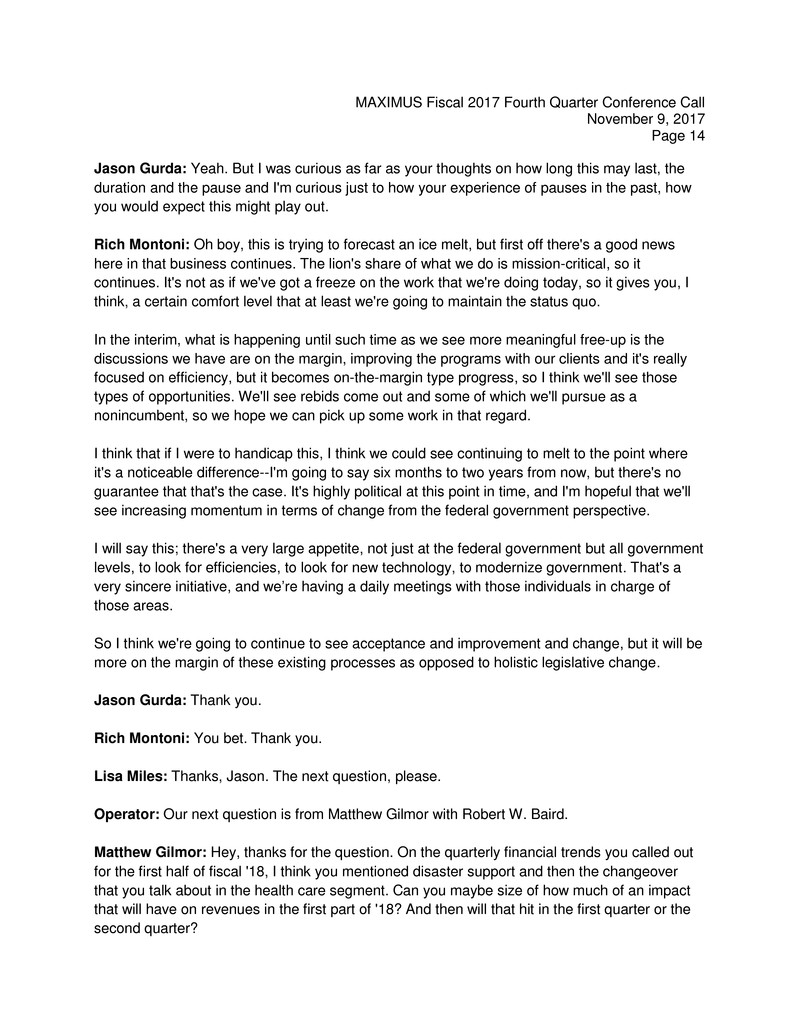
MAXIMUS Fiscal 2017 Fourth Quarter Conference Call
November 9, 2017
Page 14
Jason Gurda: Yeah. But I was curious as far as your thoughts on how long this may last, the
duration and the pause and I'm curious just to how your experience of pauses in the past, how
you would expect this might play out.
Rich Montoni: Oh boy, this is trying to forecast an ice melt, but first off there's a good news
here in that business continues. The lion's share of what we do is mission-critical, so it
continues. It's not as if we've got a freeze on the work that we're doing today, so it gives you, I
think, a certain comfort level that at least we're going to maintain the status quo.
In the interim, what is happening until such time as we see more meaningful free-up is the
discussions we have are on the margin, improving the programs with our clients and it's really
focused on efficiency, but it becomes on-the-margin type progress, so I think we'll see those
types of opportunities. We'll see rebids come out and some of which we'll pursue as a
nonincumbent, so we hope we can pick up some work in that regard.
I think that if I were to handicap this, I think we could see continuing to melt to the point where
it's a noticeable difference--I'm going to say six months to two years from now, but there's no
guarantee that that's the case. It's highly political at this point in time, and I'm hopeful that we'll
see increasing momentum in terms of change from the federal government perspective.
I will say this; there's a very large appetite, not just at the federal government but all government
levels, to look for efficiencies, to look for new technology, to modernize government. That's a
very sincere initiative, and we’re having a daily meetings with those individuals in charge of
those areas.
So I think we're going to continue to see acceptance and improvement and change, but it will be
more on the margin of these existing processes as opposed to holistic legislative change.
Jason Gurda: Thank you.
Rich Montoni: You bet. Thank you.
Lisa Miles: Thanks, Jason. The next question, please.
Operator: Our next question is from Matthew Gilmor with Robert W. Baird.
Matthew Gilmor: Hey, thanks for the question. On the quarterly financial trends you called out
for the first half of fiscal '18, I think you mentioned disaster support and then the changeover
that you talk about in the health care segment. Can you maybe size of how much of an impact
that will have on revenues in the first part of '18? And then will that hit in the first quarter or the
second quarter?
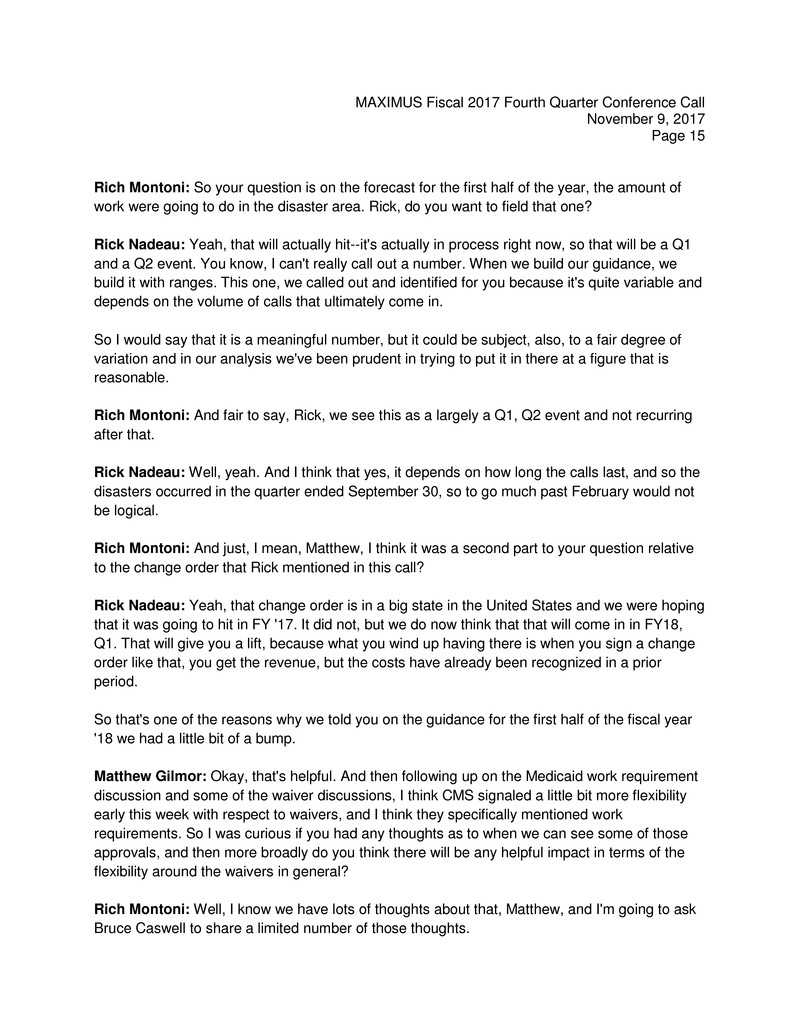
MAXIMUS Fiscal 2017 Fourth Quarter Conference Call
November 9, 2017
Page 15
Rich Montoni: So your question is on the forecast for the first half of the year, the amount of
work were going to do in the disaster area. Rick, do you want to field that one?
Rick Nadeau: Yeah, that will actually hit--it's actually in process right now, so that will be a Q1
and a Q2 event. You know, I can't really call out a number. When we build our guidance, we
build it with ranges. This one, we called out and identified for you because it's quite variable and
depends on the volume of calls that ultimately come in.
So I would say that it is a meaningful number, but it could be subject, also, to a fair degree of
variation and in our analysis we've been prudent in trying to put it in there at a figure that is
reasonable.
Rich Montoni: And fair to say, Rick, we see this as a largely a Q1, Q2 event and not recurring
after that.
Rick Nadeau: Well, yeah. And I think that yes, it depends on how long the calls last, and so the
disasters occurred in the quarter ended September 30, so to go much past February would not
be logical.
Rich Montoni: And just, I mean, Matthew, I think it was a second part to your question relative
to the change order that Rick mentioned in this call?
Rick Nadeau: Yeah, that change order is in a big state in the United States and we were hoping
that it was going to hit in FY '17. It did not, but we do now think that that will come in in FY18,
Q1. That will give you a lift, because what you wind up having there is when you sign a change
order like that, you get the revenue, but the costs have already been recognized in a prior
period.
So that's one of the reasons why we told you on the guidance for the first half of the fiscal year
'18 we had a little bit of a bump.
Matthew Gilmor: Okay, that's helpful. And then following up on the Medicaid work requirement
discussion and some of the waiver discussions, I think CMS signaled a little bit more flexibility
early this week with respect to waivers, and I think they specifically mentioned work
requirements. So I was curious if you had any thoughts as to when we can see some of those
approvals, and then more broadly do you think there will be any helpful impact in terms of the
flexibility around the waivers in general?
Rich Montoni: Well, I know we have lots of thoughts about that, Matthew, and I'm going to ask
Bruce Caswell to share a limited number of those thoughts.
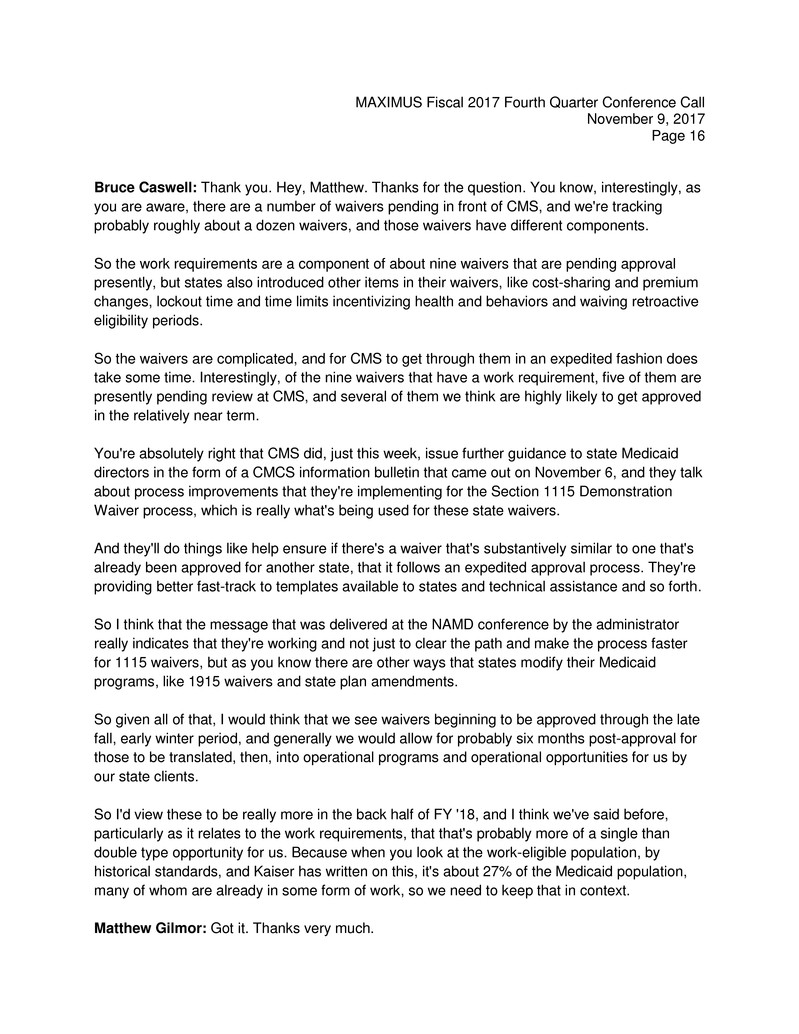
MAXIMUS Fiscal 2017 Fourth Quarter Conference Call
November 9, 2017
Page 16
Bruce Caswell: Thank you. Hey, Matthew. Thanks for the question. You know, interestingly, as
you are aware, there are a number of waivers pending in front of CMS, and we're tracking
probably roughly about a dozen waivers, and those waivers have different components.
So the work requirements are a component of about nine waivers that are pending approval
presently, but states also introduced other items in their waivers, like cost-sharing and premium
changes, lockout time and time limits incentivizing health and behaviors and waiving retroactive
eligibility periods.
So the waivers are complicated, and for CMS to get through them in an expedited fashion does
take some time. Interestingly, of the nine waivers that have a work requirement, five of them are
presently pending review at CMS, and several of them we think are highly likely to get approved
in the relatively near term.
You're absolutely right that CMS did, just this week, issue further guidance to state Medicaid
directors in the form of a CMCS information bulletin that came out on November 6, and they talk
about process improvements that they're implementing for the Section 1115 Demonstration
Waiver process, which is really what's being used for these state waivers.
And they'll do things like help ensure if there's a waiver that's substantively similar to one that's
already been approved for another state, that it follows an expedited approval process. They're
providing better fast-track to templates available to states and technical assistance and so forth.
So I think that the message that was delivered at the NAMD conference by the administrator
really indicates that they're working and not just to clear the path and make the process faster
for 1115 waivers, but as you know there are other ways that states modify their Medicaid
programs, like 1915 waivers and state plan amendments.
So given all of that, I would think that we see waivers beginning to be approved through the late
fall, early winter period, and generally we would allow for probably six months post-approval for
those to be translated, then, into operational programs and operational opportunities for us by
our state clients.
So I'd view these to be really more in the back half of FY '18, and I think we've said before,
particularly as it relates to the work requirements, that that's probably more of a single than
double type opportunity for us. Because when you look at the work-eligible population, by
historical standards, and Kaiser has written on this, it's about 27% of the Medicaid population,
many of whom are already in some form of work, so we need to keep that in context.
Matthew Gilmor: Got it. Thanks very much.
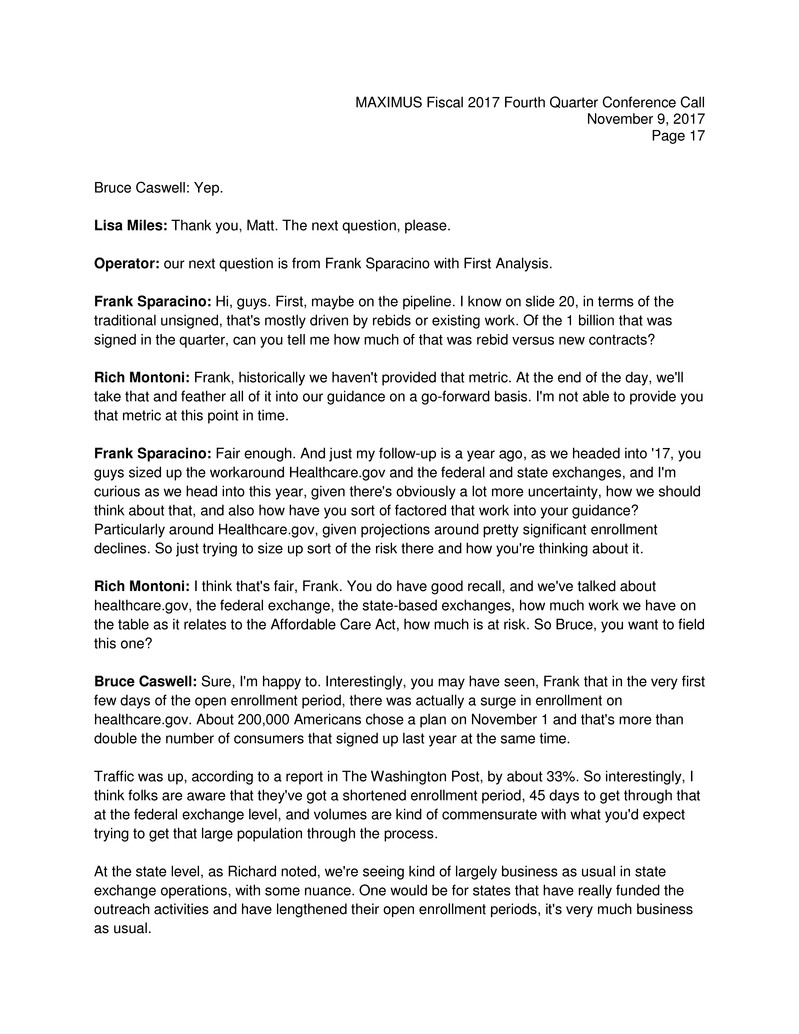
MAXIMUS Fiscal 2017 Fourth Quarter Conference Call
November 9, 2017
Page 17
Bruce Caswell: Yep.
Lisa Miles: Thank you, Matt. The next question, please.
Operator: our next question is from Frank Sparacino with First Analysis.
Frank Sparacino: Hi, guys. First, maybe on the pipeline. I know on slide 20, in terms of the
traditional unsigned, that's mostly driven by rebids or existing work. Of the 1 billion that was
signed in the quarter, can you tell me how much of that was rebid versus new contracts?
Rich Montoni: Frank, historically we haven't provided that metric. At the end of the day, we'll
take that and feather all of it into our guidance on a go-forward basis. I'm not able to provide you
that metric at this point in time.
Frank Sparacino: Fair enough. And just my follow-up is a year ago, as we headed into '17, you
guys sized up the workaround Healthcare.gov and the federal and state exchanges, and I'm
curious as we head into this year, given there's obviously a lot more uncertainty, how we should
think about that, and also how have you sort of factored that work into your guidance?
Particularly around Healthcare.gov, given projections around pretty significant enrollment
declines. So just trying to size up sort of the risk there and how you're thinking about it.
Rich Montoni: I think that's fair, Frank. You do have good recall, and we've talked about
healthcare.gov, the federal exchange, the state-based exchanges, how much work we have on
the table as it relates to the Affordable Care Act, how much is at risk. So Bruce, you want to field
this one?
Bruce Caswell: Sure, I'm happy to. Interestingly, you may have seen, Frank that in the very first
few days of the open enrollment period, there was actually a surge in enrollment on
healthcare.gov. About 200,000 Americans chose a plan on November 1 and that's more than
double the number of consumers that signed up last year at the same time.
Traffic was up, according to a report in The Washington Post, by about 33%. So interestingly, I
think folks are aware that they've got a shortened enrollment period, 45 days to get through that
at the federal exchange level, and volumes are kind of commensurate with what you'd expect
trying to get that large population through the process.
At the state level, as Richard noted, we're seeing kind of largely business as usual in state
exchange operations, with some nuance. One would be for states that have really funded the
outreach activities and have lengthened their open enrollment periods, it's very much business
as usual.
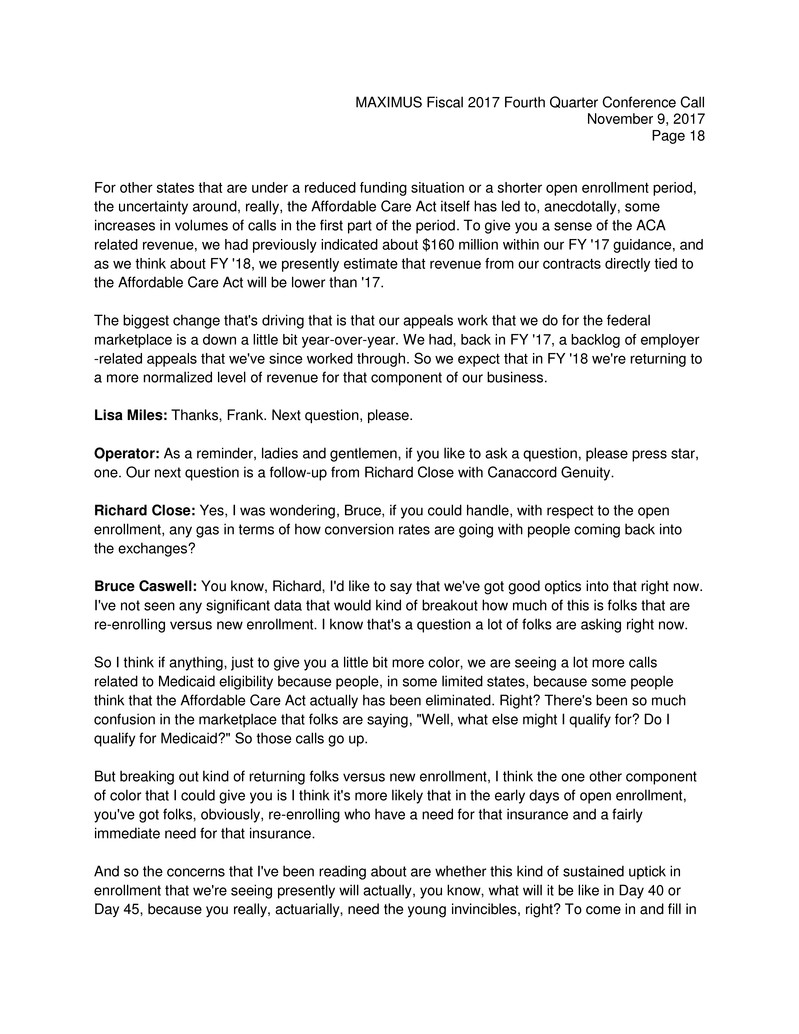
MAXIMUS Fiscal 2017 Fourth Quarter Conference Call
November 9, 2017
Page 18
For other states that are under a reduced funding situation or a shorter open enrollment period,
the uncertainty around, really, the Affordable Care Act itself has led to, anecdotally, some
increases in volumes of calls in the first part of the period. To give you a sense of the ACA
related revenue, we had previously indicated about $160 million within our FY '17 guidance, and
as we think about FY '18, we presently estimate that revenue from our contracts directly tied to
the Affordable Care Act will be lower than '17.
The biggest change that's driving that is that our appeals work that we do for the federal
marketplace is a down a little bit year-over-year. We had, back in FY '17, a backlog of employer
-related appeals that we've since worked through. So we expect that in FY '18 we're returning to
a more normalized level of revenue for that component of our business.
Lisa Miles: Thanks, Frank. Next question, please.
Operator: As a reminder, ladies and gentlemen, if you like to ask a question, please press star,
one. Our next question is a follow-up from Richard Close with Canaccord Genuity.
Richard Close: Yes, I was wondering, Bruce, if you could handle, with respect to the open
enrollment, any gas in terms of how conversion rates are going with people coming back into
the exchanges?
Bruce Caswell: You know, Richard, I'd like to say that we've got good optics into that right now.
I've not seen any significant data that would kind of breakout how much of this is folks that are
re-enrolling versus new enrollment. I know that's a question a lot of folks are asking right now.
So I think if anything, just to give you a little bit more color, we are seeing a lot more calls
related to Medicaid eligibility because people, in some limited states, because some people
think that the Affordable Care Act actually has been eliminated. Right? There's been so much
confusion in the marketplace that folks are saying, "Well, what else might I qualify for? Do I
qualify for Medicaid?" So those calls go up.
But breaking out kind of returning folks versus new enrollment, I think the one other component
of color that I could give you is I think it's more likely that in the early days of open enrollment,
you've got folks, obviously, re-enrolling who have a need for that insurance and a fairly
immediate need for that insurance.
And so the concerns that I've been reading about are whether this kind of sustained uptick in
enrollment that we're seeing presently will actually, you know, what will it be like in Day 40 or
Day 45, because you really, actuarially, need the young invincibles, right? To come in and fill in
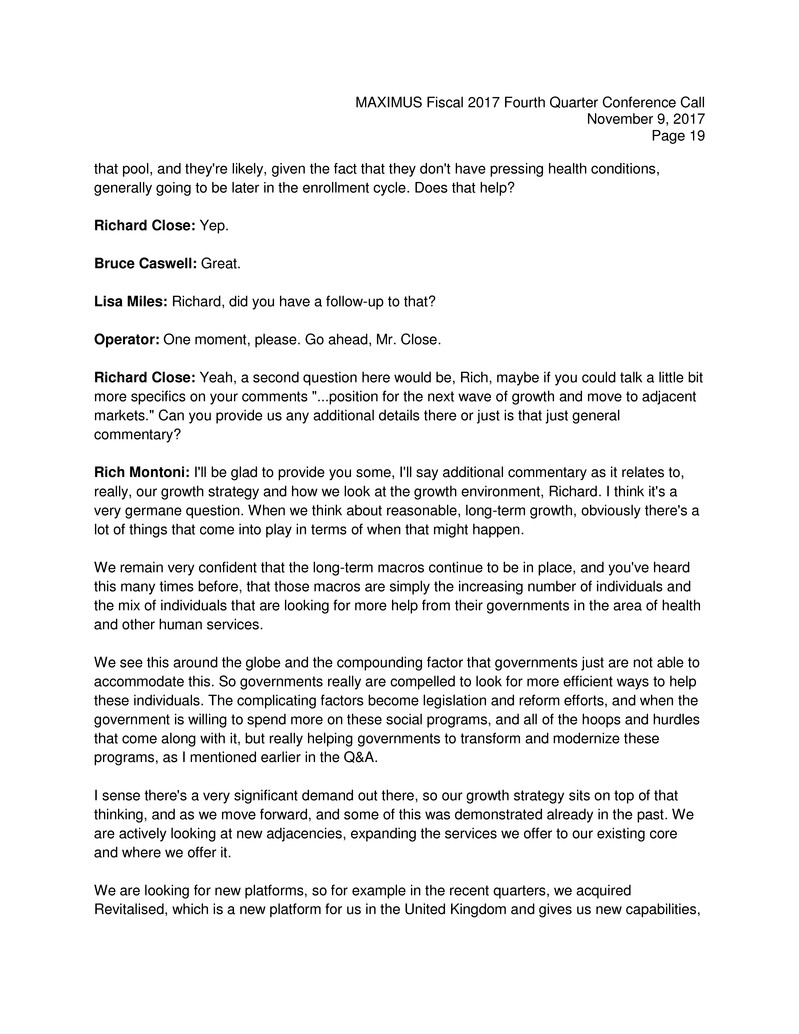
MAXIMUS Fiscal 2017 Fourth Quarter Conference Call
November 9, 2017
Page 19
that pool, and they're likely, given the fact that they don't have pressing health conditions,
generally going to be later in the enrollment cycle. Does that help?
Richard Close: Yep.
Bruce Caswell: Great.
Lisa Miles: Richard, did you have a follow-up to that?
Operator: One moment, please. Go ahead, Mr. Close.
Richard Close: Yeah, a second question here would be, Rich, maybe if you could talk a little bit
more specifics on your comments "...position for the next wave of growth and move to adjacent
markets." Can you provide us any additional details there or just is that just general
commentary?
Rich Montoni: I'll be glad to provide you some, I'll say additional commentary as it relates to,
really, our growth strategy and how we look at the growth environment, Richard. I think it's a
very germane question. When we think about reasonable, long-term growth, obviously there's a
lot of things that come into play in terms of when that might happen.
We remain very confident that the long-term macros continue to be in place, and you've heard
this many times before, that those macros are simply the increasing number of individuals and
the mix of individuals that are looking for more help from their governments in the area of health
and other human services.
We see this around the globe and the compounding factor that governments just are not able to
accommodate this. So governments really are compelled to look for more efficient ways to help
these individuals. The complicating factors become legislation and reform efforts, and when the
government is willing to spend more on these social programs, and all of the hoops and hurdles
that come along with it, but really helping governments to transform and modernize these
programs, as I mentioned earlier in the Q&A.
I sense there's a very significant demand out there, so our growth strategy sits on top of that
thinking, and as we move forward, and some of this was demonstrated already in the past. We
are actively looking at new adjacencies, expanding the services we offer to our existing core
and where we offer it.
We are looking for new platforms, so for example in the recent quarters, we acquired
Revitalised, which is a new platform for us in the United Kingdom and gives us new capabilities,
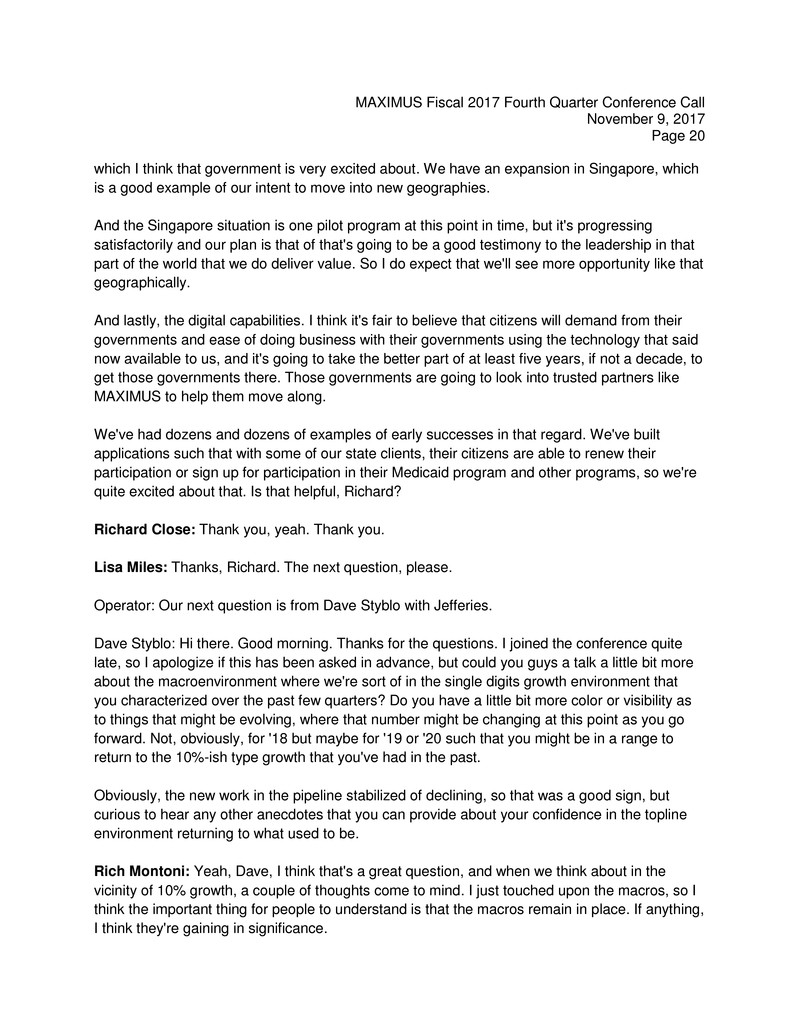
MAXIMUS Fiscal 2017 Fourth Quarter Conference Call
November 9, 2017
Page 20
which I think that government is very excited about. We have an expansion in Singapore, which
is a good example of our intent to move into new geographies.
And the Singapore situation is one pilot program at this point in time, but it's progressing
satisfactorily and our plan is that of that's going to be a good testimony to the leadership in that
part of the world that we do deliver value. So I do expect that we'll see more opportunity like that
geographically.
And lastly, the digital capabilities. I think it's fair to believe that citizens will demand from their
governments and ease of doing business with their governments using the technology that said
now available to us, and it's going to take the better part of at least five years, if not a decade, to
get those governments there. Those governments are going to look into trusted partners like
MAXIMUS to help them move along.
We've had dozens and dozens of examples of early successes in that regard. We've built
applications such that with some of our state clients, their citizens are able to renew their
participation or sign up for participation in their Medicaid program and other programs, so we're
quite excited about that. Is that helpful, Richard?
Richard Close: Thank you, yeah. Thank you.
Lisa Miles: Thanks, Richard. The next question, please.
Operator: Our next question is from Dave Styblo with Jefferies.
Dave Styblo: Hi there. Good morning. Thanks for the questions. I joined the conference quite
late, so I apologize if this has been asked in advance, but could you guys a talk a little bit more
about the macroenvironment where we're sort of in the single digits growth environment that
you characterized over the past few quarters? Do you have a little bit more color or visibility as
to things that might be evolving, where that number might be changing at this point as you go
forward. Not, obviously, for '18 but maybe for '19 or '20 such that you might be in a range to
return to the 10%-ish type growth that you've had in the past.
Obviously, the new work in the pipeline stabilized of declining, so that was a good sign, but
curious to hear any other anecdotes that you can provide about your confidence in the topline
environment returning to what used to be.
Rich Montoni: Yeah, Dave, I think that's a great question, and when we think about in the
vicinity of 10% growth, a couple of thoughts come to mind. I just touched upon the macros, so I
think the important thing for people to understand is that the macros remain in place. If anything,
I think they're gaining in significance.
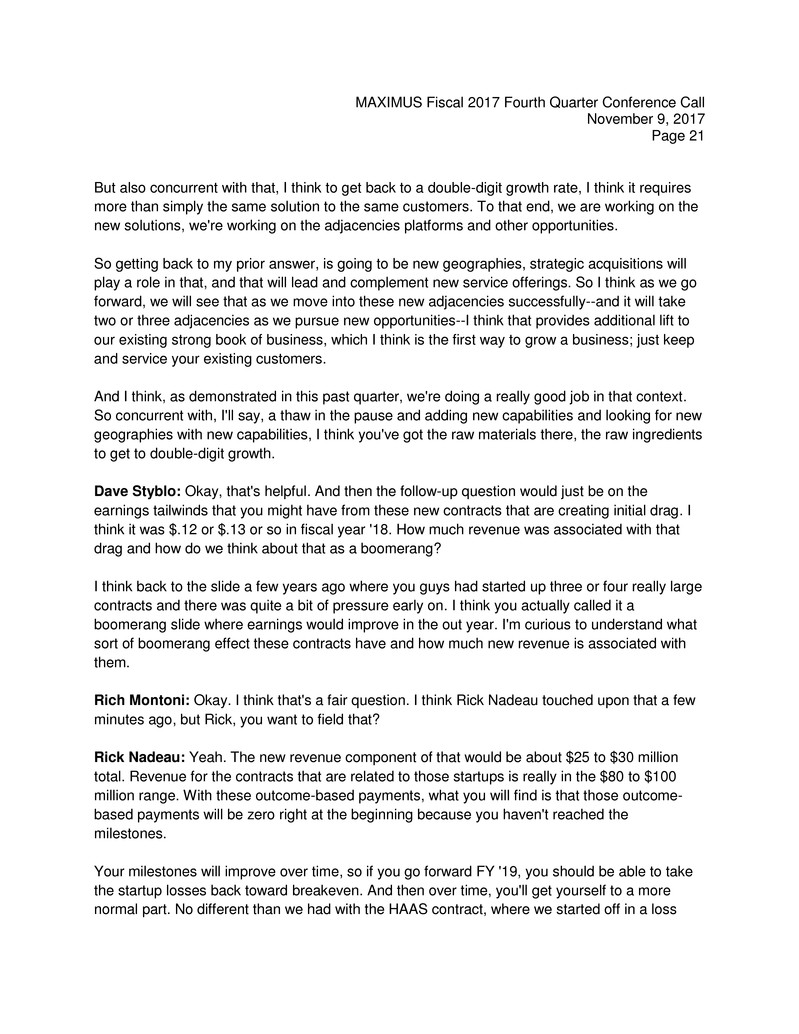
MAXIMUS Fiscal 2017 Fourth Quarter Conference Call
November 9, 2017
Page 21
But also concurrent with that, I think to get back to a double-digit growth rate, I think it requires
more than simply the same solution to the same customers. To that end, we are working on the
new solutions, we're working on the adjacencies platforms and other opportunities.
So getting back to my prior answer, is going to be new geographies, strategic acquisitions will
play a role in that, and that will lead and complement new service offerings. So I think as we go
forward, we will see that as we move into these new adjacencies successfully--and it will take
two or three adjacencies as we pursue new opportunities--I think that provides additional lift to
our existing strong book of business, which I think is the first way to grow a business; just keep
and service your existing customers.
And I think, as demonstrated in this past quarter, we're doing a really good job in that context.
So concurrent with, I'll say, a thaw in the pause and adding new capabilities and looking for new
geographies with new capabilities, I think you've got the raw materials there, the raw ingredients
to get to double-digit growth.
Dave Styblo: Okay, that's helpful. And then the follow-up question would just be on the
earnings tailwinds that you might have from these new contracts that are creating initial drag. I
think it was $.12 or $.13 or so in fiscal year '18. How much revenue was associated with that
drag and how do we think about that as a boomerang?
I think back to the slide a few years ago where you guys had started up three or four really large
contracts and there was quite a bit of pressure early on. I think you actually called it a
boomerang slide where earnings would improve in the out year. I'm curious to understand what
sort of boomerang effect these contracts have and how much new revenue is associated with
them.
Rich Montoni: Okay. I think that's a fair question. I think Rick Nadeau touched upon that a few
minutes ago, but Rick, you want to field that?
Rick Nadeau: Yeah. The new revenue component of that would be about $25 to $30 million
total. Revenue for the contracts that are related to those startups is really in the $80 to $100
million range. With these outcome-based payments, what you will find is that those outcome-
based payments will be zero right at the beginning because you haven't reached the
milestones.
Your milestones will improve over time, so if you go forward FY '19, you should be able to take
the startup losses back toward breakeven. And then over time, you'll get yourself to a more
normal part. No different than we had with the HAAS contract, where we started off in a loss
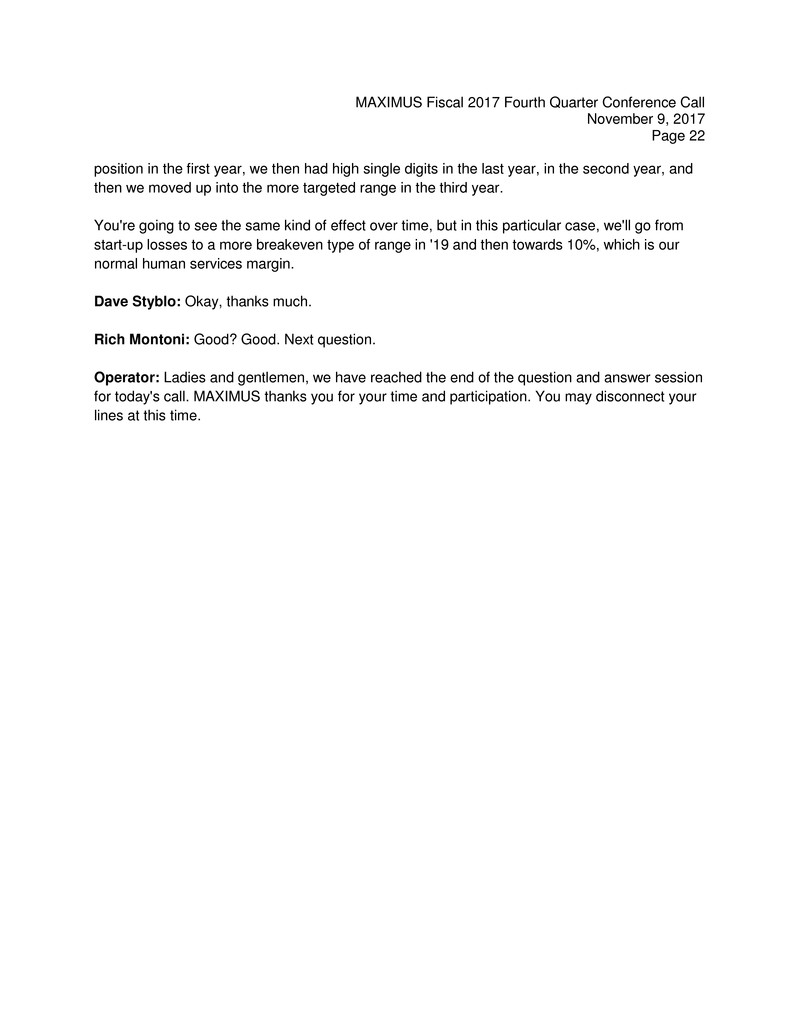
MAXIMUS Fiscal 2017 Fourth Quarter Conference Call
November 9, 2017
Page 22
position in the first year, we then had high single digits in the last year, in the second year, and
then we moved up into the more targeted range in the third year.
You're going to see the same kind of effect over time, but in this particular case, we'll go from
start-up losses to a more breakeven type of range in '19 and then towards 10%, which is our
normal human services margin.
Dave Styblo: Okay, thanks much.
Rich Montoni: Good? Good. Next question.
Operator: Ladies and gentlemen, we have reached the end of the question and answer session
for today's call. MAXIMUS thanks you for your time and participation. You may disconnect your
lines at this time.